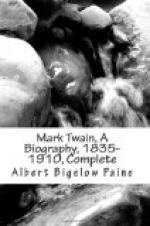The authors regarded their work highly when it was finished, but that is nothing. Any author regards his work highly at the moment of its completion. In later years neither of them thought very well of their production; but that also is nothing. The author seldom cares very deeply for his offspring once it is turned over to the public charge. The fact that the story is still popular, still delights thousands of readers, when a myriad of novels that have been written since it was completed have lived their little day and died so utterly that even their names have passed out of memory, is the best verdict as to its worth.
LXXXIX
PLANNING A NEW HOME
Clemens and his wife bought a lot for the new home that winter, a fine, sightly piece of land on Farmington Avenue—table-land, sloping down to a pretty stream that wound through the willows and among the trees. They were as delighted as children with their new purchase and the prospect of building. To her sister Mrs. Clemens wrote:
Mr. Clemens seems to glory
in his sense of possession; he goes daily
into the lot, has had several
falls trying to lay off the land by
sliding around on his feet....
For three days the ice has covered the trees, and they have been glorious. We could do nothing but watch the beauty outside; if you looked at the trees as the sun struck them, with your back toward the sun, they were covered with jewels. If you looked toward the sun it was all crystal whiteness, a perfect fairy-land. Then the nights were moonlight, and that was a great beauty, the moon giving us the same prismatic effect.
This was the storm of which Mark Twain wrote his matchless description, given first in his speech on New England weather, and later preserved in ‘Following the Equator’, in more extended form. In that book he likens an ice-storm to his impressions derived from reading descriptions of the Taj Mahal, that wonderful tomb of a fair East Indian queen. It is a marvelous bit of word-painting—his description of that majestic vision: “When every bough and twig is strung with ice-beads, frozen dewdrops, and the whole tree sparkles cold and white, like the Shah of Persia’s diamond plume.” It will pay any one to look up that description and read it all, though it has been said, by the fortunate one or two who heard him first give it utterance as an impromptu outburst, that in the subsequent process of writing the bloom of its original magnificence was lost.
The plans for the new house were drawn forthwith by that gentle architect Edward Potter, whose art to-day may be considered open to criticism, but not because of any lack of originality. Hartford houses of that period were mainly of the goods-box form of architecture, perfectly square, typifying the commercial pursuits of many of their owners. Potter agreed to get away from this idea, and a radical and even frenzied




